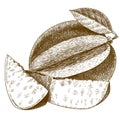Designed by
Title
Antique illustration of the lancelet. Vintage illustration of the lancelet. Antique picture of the lancelet. Cross #262024927
Description
Antique illustration of the lancelet. Vintage illustration of the lancelet. Antique picture of the lancelet. Cross section, figure legend. The lancelets , also known as amphioxi (singular: amphioxus), consist of some 30 to 35 species of fish-like benthic filter feeding chordates in the order Amphioxiformes. They are the modern representatives of the subphylum Cephalochordata. Lancelets closely resemble 530-million-year-old Pikaia, fossils of which are known from the Burgess Shale. Zoologists are interested in them because they provide evolutionary insight into the origins of vertebrates. Lancelets contain many organs and organ systems that are closely related to those of modern fish, but in more primitive form. Therefore, they provide a number of examples of possible evolutionary exaptation. For example, the gill-slits of lancelets are used for feeding only, and not for respiration. The circulatory system carries food throughout their body, but does not have red blood cells or hemoglobin for transporting oxygen. Lancelet genomes hold clues about the early evolution of vertebrates: by comparing genes from lancelets with the same genes in vertebrates, changes in gene expression, function and number as vertebrates evolved can be discovered. The genome of a few species in the genus Branchiostoma have been sequenced: B. floridae, B. belcheri, and B. lanceolatum. In Asia, lancelets are harvested commercially as food for humans and domesticated animals. In Japan, amphioxus (B. belcheri) has been listed in the registry of Endangered Animals of Japanese Marine and Fresh Water Organisms .















